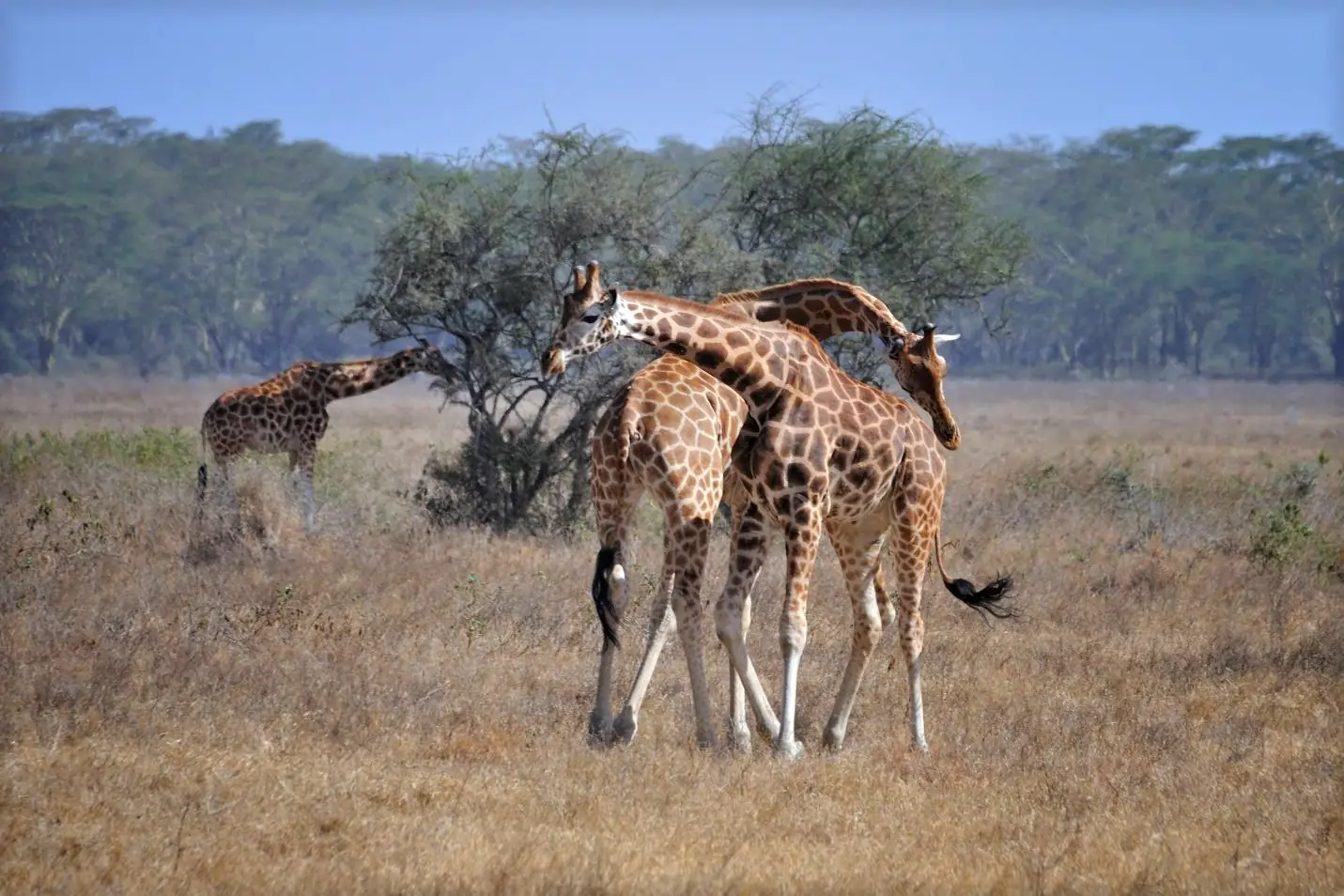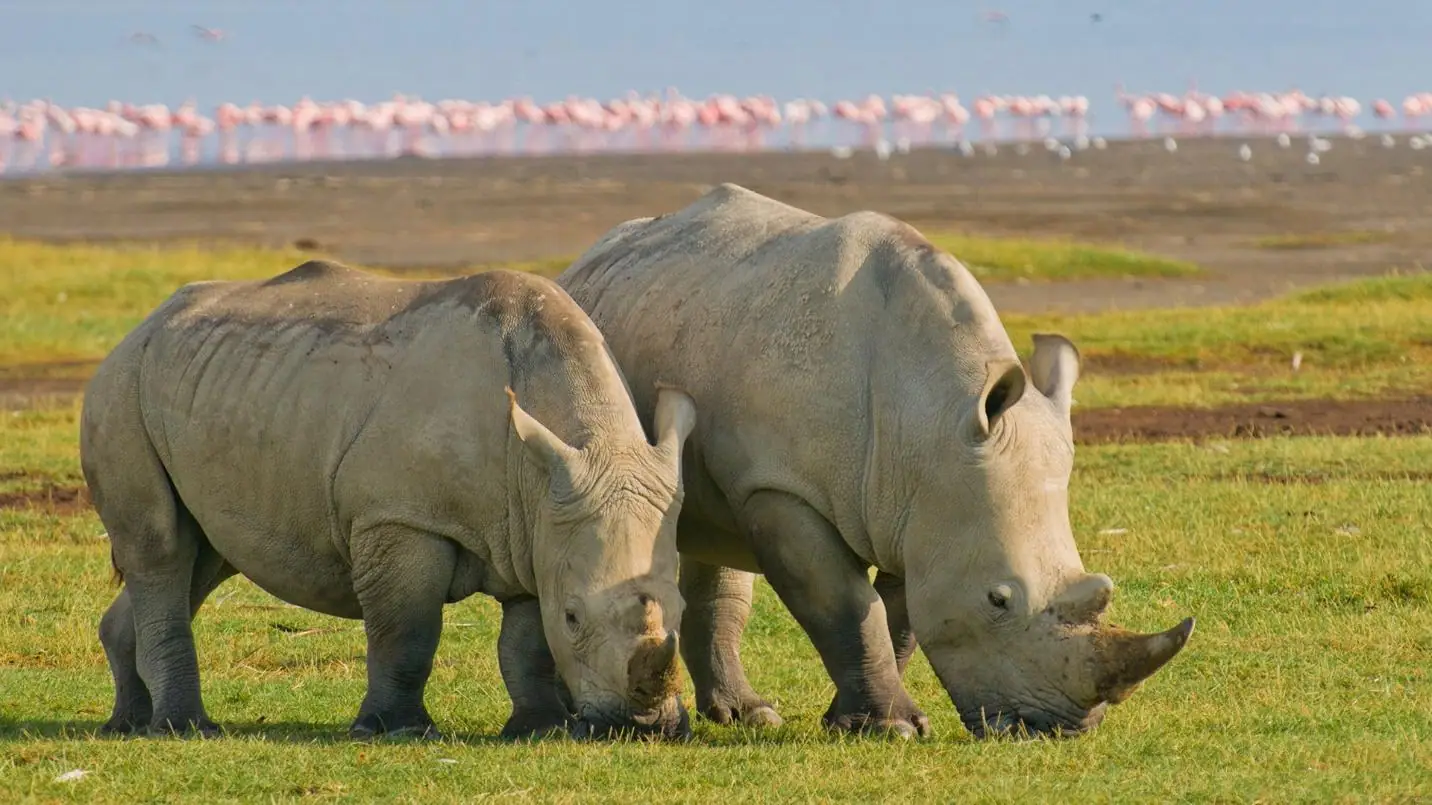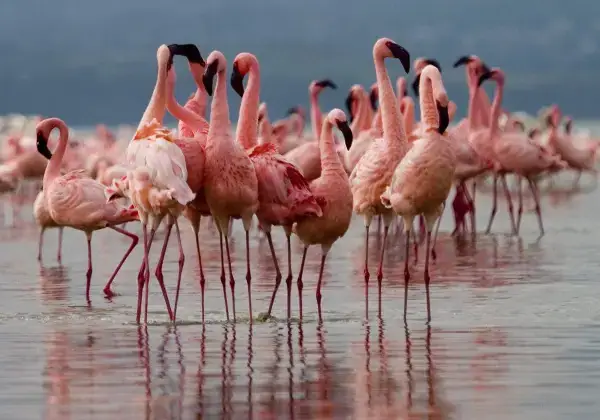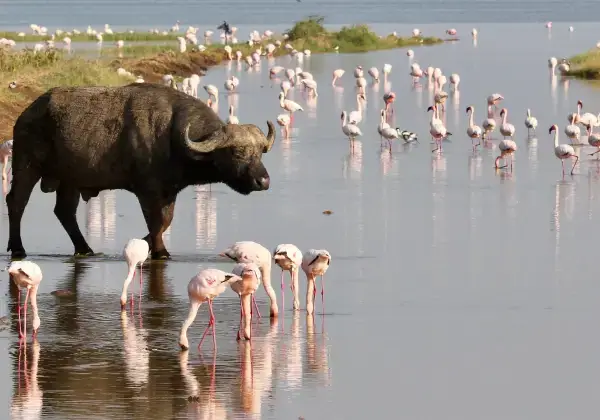Discover the Best of Lake Nakuru National Park: Your Ultimate Guide
Lake Nakuru National Park
Lake Nakuru National Park, situated in the center of Kenya, is an amazing destination famous for its breathtaking beauty and rich biodiversity. Found within the Great Rift Valley, this park is home to many different species of animals and a haven for nature lovers.
Spanning some 188 square kilometers, the park is centered on Lake Nakuru, a shallow alkaline lake renowned for its resplendent beauty and ecological importance. It’s an important feeding ground for numerous bird species, including the mythical lesser flamingos whose population sometimes reaches millions and stains the lake shore a marvelous pink wonder. This phenomenon of color within the flamingo population forms one of the most spectacular sights in the park.
Other than the flamingos, Lake Nakuru National Park has an incredible diversity of wildlife species. Black and white rhinos, which roam freely in the rhino sanctuary, Rothschild giraffes, lions, leopards, and African wild dogs are some of the creatures that visitors can spot. The park’s diverse habitats, from bushy grasslands to euphorbia forests, are perfect for these animals to inhabit.
For bird lovers and bird watchers, the park is a haven for birds with over 450 species of birds, including the African fish eagle and the goliath heron. The variety of birds as well as other animals make it a great destination for wildlife enthusiasts and wildlife photographers.
Scenic spots such as Baboon Cliff and Lion Hill offer birds’ eye views of the lake and the park, allowing visitors to appreciate the park’s natural beauty from above. The Makalia Waterfalls, located near the south-eastern boundary, also offer a scenic spot for relaxation and exploration.
Whether you are heading out on a game drive, on a day trip from the town of Nakuru, or to the neighboring national reserves of Hell’s Gate National Park, Lake Nakuru National Park has something for you. Its proximity to Nairobi ensures that it is an easy and worthwhile place for those who need to see the beauty of the national parks and conservation areas in Kenya.

Wildlife
Lake Nakuru National Park is renowned for its incredible diversity of wildlife and is therefore a paradise for nature lovers. The park is perhaps best known for the stunning flocks of flamingos on the shores of Lake Nakuru, which present an overwhelming pink vista. This alkaline lake is a key feeding ground for these lesser flamingos by the hundreds of thousands at times, and the spectacle is wonderful.
Other than flamingos, the park is home to black and white rhinos, and it has a protection area within its rhino sanctuary where the magnificent creatures can roam freely. The park also has the rare Rothschild’s giraffe, a subspecies that can be seen nowhere else. The park’s diverse habitats, ranging from grassland bush to euphorbia woodland, are home to a rich variety of wildlife species, including lions, leopards, and African wild dogs.
Birdwatchers will enjoy Lake Nakuru National Park, which is home to over 450 species of birds. The birds that are present include the African fish eagle, goliath heron, and various bird species found in the bird sanctuary. Biodiversity in the park coupled with the awe-inspiring view makes it a great location for photographers and wildlife lovers alike.
Scenic viewpoints such as Baboon Cliff and Lion Hill offer panoramic views of the lake and the park, and perfect moments to take in the beauty of the park from the top. The Makalia Waterfalls, situated near the south-east boundary, add to the beauty of the park with a scenic area to relax and explore.
Whether you are going on a game drive, going there on a day trip from Nakuru town, or heading out to the surrounding national reserves of Hell’s Gate National Park, Lake Nakuru National Park offers something different. As close to Nairobi as you can get for Kenya’s national parks and conservation areas, it is a convenient but satisfying place for those interested in seeing the beauty of Kenya’s national parks and conservation areas.

Main Attractions
Lake Nakuru National Park is a gold rush of natural points of interest and wildlife displays. Its biggest thrill is undoubtedly the large number of flamingos blanketing the lake with a remarkable pink hue, offering an astonishing sight drawing holidaymakers from all over the world. These small flamingos mate in the lake’s shallow alkaline waters where they feed on the dense algae, and at times their number increases to a million, creating a pink utopia.
Apart from the flamingos, the park is renowned for rhino sightings. As a committed rhino sanctuary, Lake Nakuru provides a refuge for black and white rhinos. Visitors have the exclusive opportunity of approaching these great creatures closely, and therefore it is one of the best places in Kenya where one can spot rhinos in the wild.
Rothschild giraffes, with their distinctively patterned coats, also roam the park, adding to the diverse array of wildlife. These rare giraffes are a subspecies unique to the region and are a must-see for wildlife enthusiasts.
Scenic vantage points such as Baboon Cliff and Lion Hill offer panoramic views of the lake and park. They provide tourists with amazing vistas of the landscape and are perfect spots to snap photos and relax.
Additionally, the Makalia Waterfalls, which are near the south-eastern boundary, create a serene and scenic setting for those visiting to explore and unwind. The waterfalls are particularly magical during the rainy season when the water flow is most powerful.
Whether it’s a game drive, birdwatching, or simply soaking in nature’s splendor, Lake Nakuru National Park’s top destinations present a diverse and memorable experience for all who visit.
Climate
The park has a moderate climate ranging from 15°C to 30°C. The park enjoys two rainy seasons, namely March to May and October to December. The park’s lush vegetation flourishes during these periods, creating a vibrant backdrop for wildlife viewing. The rains renew the park’s ecosystems, filling up the lake and the forest vegetation, thus sustaining a rich variety of wildlife species. Rainy-season tourists are lucky enough to see the park transformed into a green paradise full of more fauna and avifauna flight.
Even with the rains, the park is still accessible, and the lower temperatures create a comfortable setting for discovery. The green scenery and dramatic clouds during this period offer photographers great chances to showcase the park in a new perspective. The rainy season is also usually less populated, providing an even more private and serene encounter with nature.
Whether visiting during the dry or rainy season, Lake Nakuru National Park offers a dynamic climate that enhances the overall safari experience, making it a year-round destination for nature enthusiasts and wildlife photographers alike.

Experience
Lake Nakuru National Park offers a rich tapestry of experiences for visitors, ensuring that every moment spent within its boundaries is filled with wonder and discovery. The park’s diverse habitats and abundant wildlife create an ideal setting for a variety of activities that cater to different interests.
Visitors on safari to Lake Nakuru can enjoy game drives, bird watching, and picnicking with stunning views of the lake. Game drives are a popular way to explore the park, providing an opportunity to witness the park’s wildlife in their natural habitat. Whether you’re tracking the movements of the majestic lions or observing the playful antics of the Rothschild giraffes, each drive is an adventure in itself.
Bird watching is another highlight of the park, with over 450 bird species to discover. From the iconic lesser flamingos that grace the lake’s shores to the powerful African fish eagle soaring above, bird enthusiasts will find themselves in a true avian paradise. The park’s status as a bird sanctuary ensures that there are endless opportunities to spot both resident and migratory birds.
For those seeking a more leisurely experience, picnicking at designated sites offers a chance to relax and soak in the breathtaking views. Imagine enjoying a meal surrounded by the sounds of nature, with the shimmering lake as your backdrop.
Best Time To Visit
The Best Time to Visit Lake Nakuru National Park is during the dry months of June to October. During this period, vegetation is minimal, and hence it is easy to spot more wildlife, while animals also migrate to the shores of the lake in large numbers, making excellent conditions for wildlife viewing. The dry season also brings along the tourist peak season when weather conditions for outdoor activities like safaris are ideal.
Traveling during the dry season also means that the roads are more accessible, and the likelihood of rain spoiling your plans is minimal. The good weather and nice temperatures make it perfect for strolling around the park or driving within it. It must be noted, however, that even though the dry season is more popular, the beauty of the park and its wildlife can be accessed all year round.
For those who prefer a less populated experience, visiting during the rainy season from March to May or October to December can be equally rewarding. The park is a green paradise, with fewer visitors and another kind of beauty to appreciate. The rains bring life to the landscape, and the increased animal activity and bird migrations offer special viewing experiences.
Whenever you choose to visit, Lake Nakuru National Park promises a visit to cherish, with nature’s beauty and discovery’s thrill.
Things to Do
- Game Drives: Embark on guided game drives to explore the park’s diverse habitats and spot wildlife such as rhinos, lions, and leopards. Morning and evening drives are most fruitful.
- Bird Watching: The Lake Nakuru is famous for its birds, especially the flamingos that appear in their thousands. Bring along a pack of binoculars to catch a sight of these and other bird species.
- Hiking and Nature Walks: Find yourself discovering the park on foot through hikes and guided nature walks. Baboon Cliff and Lion Hill offer sweeping vistas of the lake and landscape.
- Picnicking: There are special picnic areas in the park where one can have a meal in a wonderful setting amidst nature.
- Photography: Take advantage of the incredible landscapes and variety of wildlife.

Highlights
- Flamingos: Lake Nakuru is famous for its huge population of flamingos, which make the shoreline appear pink. Flamingo populations fluctuate depending on water levels and food supplies.
- Rhinos: The park has black and white rhinos, and it is among the best places in Kenya to see these incredible creatures.
- Scenic Views: Baboon Cliff and Lion Hill provide stunning panoramic views of the lake and the park.
- Makalia Falls: The park’s scenic waterfall is a beautiful spot to visit, especially during the rainy season when it is at its most dramatic.
Finally, Lake Nakuru National Park provides the peaceful coexistence of diverse ecosystems, from the renowned flamingo-inhabited lake to the rhino-studded savannas. If you’re keen on birdlife, seeking close range encounters with rhinos, or basking in the park’s scenic splendor, a visit to Lake Nakuru promises an unforgettable safari experience in the heart of Kenya’s Rift Valley. For us at Seremara Safaris, this is our home park, and we are that much prouder to share it with you.
What Our Clients Say About Kenya Holiday Safaris
Posted onVerified An incredible trip with Seremara Safaris! We recently returned from an incredible trip organized by Benson at Seremara Safaris, and we couldn’t be happier with the experience. Like many, we were initially a bit nervous booking online, but Benson was absolutely amazing from start to finish. Everything was flawlessly arranged, and we never had to worry about a thing.Benson coordinated our entire journey - from airport transfers in Nairobi, hotel stays, domestic flights to the Masai Mara and Diani Beach, and all accommodations and transfers in between. His attention to detail was impeccable, and his recommendations for places to stay were spot-on.We spent two nights at Basecamp Masai Mara and one night at Eagle View. We had a great time at Basecamp and wouldn’t change that part, but we absolutely loved Eagle View and would definitely spend two nights there next time as well! Whilst on safari we saw a huge number of animals, including four of the big 5. We had great guides in both camps, but worth a special mention to Safari Steve who was amazing! He was so informative and very passionate, which was infectious. A particularly thoughtful touch was Benson coming to meet us personally at the airports twice during our trip just to check in and make sure everything was going well. That level of care really stood out.We've been enthusiastically recommending Seremara Safaris to all our friends since coming home, and we would happily book with Benson again. Thank you for making our trip so special!Posted onVerified amazing service & reasonable price we lived amazing experience with amazing guides , very kind and helpful everything was exactly like what they promised i liked their honesty and flexibility , i get a reasonable price ,the service and the experience absolutely worth itPosted onVerified Excellent organization of the whole trip to Samburu. Excellent planning and smooth operation of our tour to Samburu. Benson arranged the trip complete with flights, accommodation, vehicle and our very own very knowledgable guide Jackson. One of the best wildlife trips we’ve been on from beginning to end!Posted onVerified Trip of a lifetime Seremara Safaris provided my daughters and me with the trip of a lifetime. Benson Ndunyu, tours manager, designed a safari specifically to meet our needs and desires. He was prompt with responses, professional, personable and added touches that went above and beyond. Our guide Jack was knowledgeable, outgoing, intelligent, and funny. Our safari was affordable and intimate. It was just the three of us with Jack in the vehicle which enabled us to determine how long to watch certain animals, which animals to look for and ensured that we could always see the animals easily. We did indeed see every animal we hoped to see and learned about their behaviors and interconnectedness. Driving rather than flying between parks gave us the opportunity to see different parts of Kenya and to learn from Jack about the various tribes and cultures we passed. I highly recommend Seremara Safaris for an experience you will never forget and always cherish.Posted onVerified Amazing time! I discovered Benson through this Safari Bookings site, but I also got 2 quotes from other travel agents that were recommended by friends who lived in Kenya. We wanted to go to Diani Beach after, and Benson was the only one who worked with me to find a direct flight to the coast and also negotiated with the airline to get a better price. All the other agents just said I had to fly back to Wilson Airport first, and weren't very flexible nor helpful. Benson also helped to book us the SGR train back from Mombasa to Nairobi, as online bookings require mPesa which I don't have as a non-Kenyan.The other tour operators just offered one place to stay all 3 nights, but Seremara had the option of 2 nights in the Mara and 1 night in Naibosho. To be honest, I had no idea what the difference was at the time, so I never would have considered this on my own, but I'm glad that Benson's tour package offered this. It really is great to experience time in Maasai Mara and a night in one of the adjoining private conservatories, because you get different experiences.Overall, my husband and I had an amazing time and we would highly recommend you travel with Seremara!Posted onVerified Excellent Kenya Safari Before visiting Kenya we had high expectations of what an African Safari holiday should be like. These expectations were exceeded because the personalised service was excellent and very aligned with our needs. The travel was comfortable , the game viewing spectacular and hotels service was world classPosted onVerified Outstanding!!! A big thank you to Benson for arranging a truly once in a lifetime experience.From start to finish our visit to Kenya has been exceptional and that is all down to Benson and his brilliant organisation.From airport transfers to arranging a five day excursion (Nairobi Day Tour,4 Day Nakuru/Masai Mara Safari) the trip was faultless in every aspect.Thomas was a fantastic guide and we managed to see the Big 5 within half a day of being at the Mara due to his incredible knowledge and experience!The accommodation (Cliff - Nakuru,Kichwa Tembo - Masai Mara) were both perfect and we thoroughly enjoyed every moment!Sunrise Hot Air Ballon Tour is an absolute must!Thank You/Asaanti Kenya you’ve been true a pleasure!🙏🏽Posted onVerified Benson went above and beyond to accommodate our needs and ensure we had an excellent trip Seremara Safaris had amazing attentive staff and guides who went above and beyond to accommodate our wants / needs. We had outstanding safaris in the park and conservancy. Our accommodations were beyond expectations, the meals were excellent as well. We had so many unforgettable experiences and encounters. I would highly recommend booking with Seremara Safaris to ensure a seamless trip.Posted onVerified Wonderful for Solo Travellers! I used Seremara Safari to book my trip to the Masai Maara and it was wonderful. I felt completely safe a a woman solo traveller and will definitely use them again when I return to Kenya!!Posted onVerified Excellent Seremara Safaris booked a wonderful 3-night safari at Basecamp and Leopard hill. Our guide Tonkei was amazing, we saw leopards, lions, hyenas, elephants, buffalo, hippos, and even a cheetah kill. The basecamp staff and Leopard hill staff were so friendly and kind. We felt so cared for throughout our stay, especially mealtimes.Benson was a great communicator, giving us a link to the e-visa for Kenya, and details about each camp. We were 3 friends that wanted to be in the same tent, and all that worked out splendidly. My friend had never been to Kenya before this trip and left saying she was excited to come again. Thanks Seremara!
BOOK TODAY and enjoy a 10% DISCOUNT on an unforgettable safari experience with Kenya Holiday Safaris!
